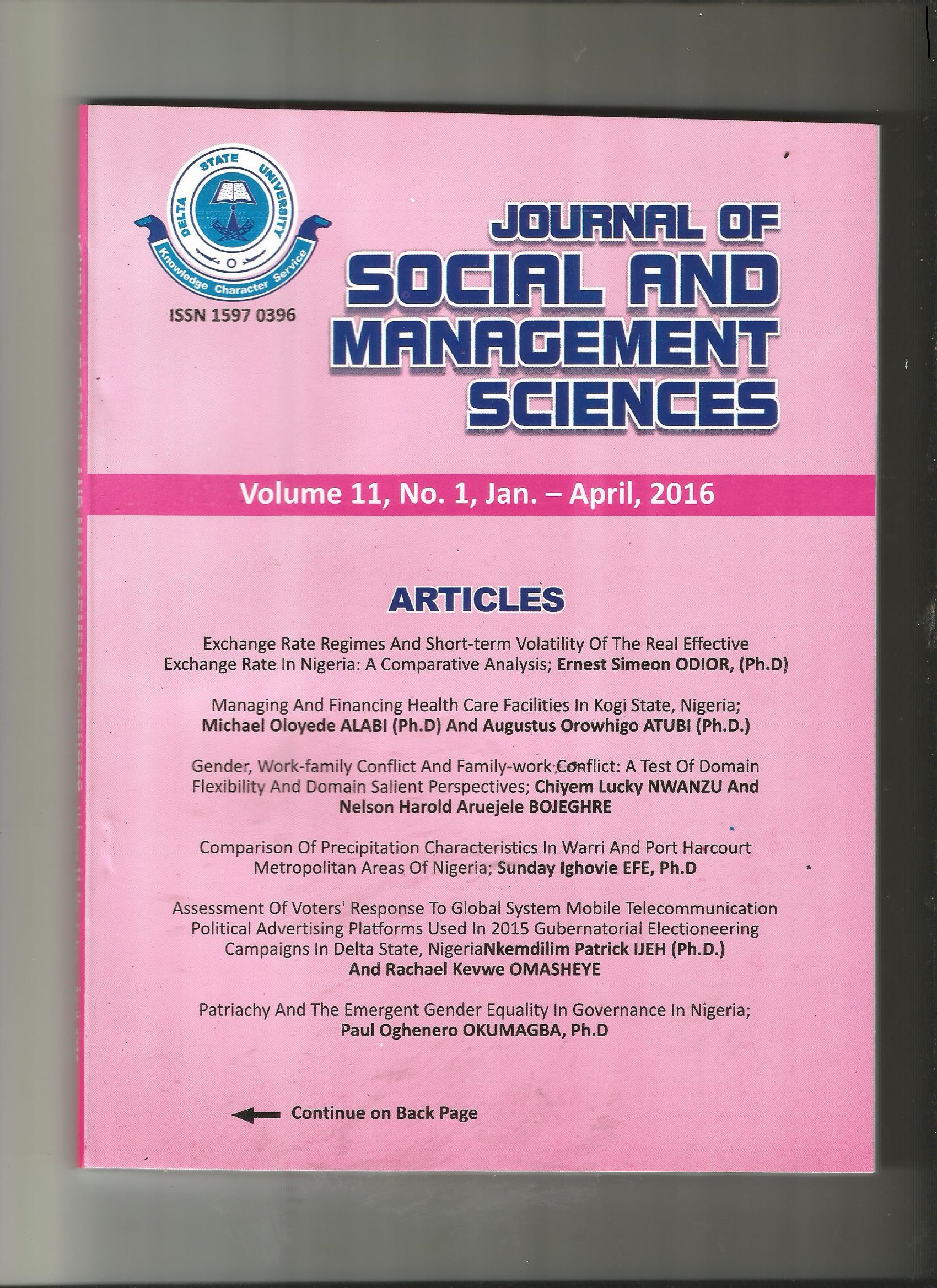
JOURNAL OF SOCIAL AND MANAGEMENT SCIENCES
Journal of the Faculty of Social Sciences, Delta State University, Abraka, Nigeria
ISSN: 1597-0396
DOI: 10.5987/UJ-JSMS
Email: jsms@universityjournals.org
KNOWLEDGE ATTITUDES AND PRACTICES REGARDING HIV/AIDS PREVENTIVE MEASURES AMONG YOUTHS IN FAGGE LOCAL GOVERNMENT AREA OF KANO STATE, NIGERIA
DOI: 10.5987/UJ-JSMS.17.042.3 | Article Number: EC0D521 | Vol.11 (3) - December 2016
Author: NAMADI Mohammed Mustapha
Keywords: HIV/AIDS, Youths, Knowledge, Attitudes, Practices
Knowledge, attitudes and practices regarding HIV/AIDS are the corner stones in the fight against the disease.The youths are most vulnerable to HIV/AIDS infection because they engaged in risky practices due to lack of adequate information. The study examined knowledge, attitude and practice of preventive measures against HIV/AIDS among youths in Fagge Local Government Area of Kano State, Nigeria. A sample size of 220 study participants was drawn from five political wards in Fagge Local Government Area of Kano State, using multi-staged and purposive sampling techniques. The data for the study were collected using questionnaire and analyzed using Statistical Package for Social Sciences (SPSS). The findings revealed that majority of the respondents have heard of at least one of HIV/AIDS preventive methods. Abstinence from sex, faithfulness to one's partner, usage of condom, avoidance of sharing needle and health education were the commonly known preventive measures. The findings also revealed that majority of the respondents did not think that avoiding multiple partners or abstinence would be of any use in avoiding HIV/AIDS. More than half the respondents had never used a condom, and only about one third of the respondents had taken a HIV test. This study suggests a need to intensify HIV/AIDS awareness campaigns, particularly targeting the youth, so as to help them develop proper understanding of HIV/AIDS and its preventive measures.
Akwuwe C. (1999): HIV/AIDS in African Children: Major calamity that Deserve Urgent Global Action Journal on HIV prevention. Education for Adolescents and Children Vol(IV) NO.11
Anochie, I.C. & Ikpeme, E.E. (2001). Prevalence of sexual activity and outcome among female secondary school students in Port Harcourt, Nigeria. African Journal of Reproductive Health, 5: 63-67.
Asekun-Olarinmoye E. O., Olajide F. O. & Asekun- Olarinmoye I. O. (2011). HIV/AIDS Preventive Measures among In-school Adolescents in a Sub-Urban Community in Southwestern Nigeria. Journal Life& Physical Sciences, 4(1): 81 – 96
Ayankogbe, O.O., Omotola, B.D., Inem, V.A., Ahmed, O.A. and Manafa, O.U. (2003). Knowledge, attitudes, beliefs and behavioural practices for creating awareness about HIV/AIDS in Lagos State, Nigeria. Nigerian Medical Practitioner, 3(44): 7-10.
Babbie, E. and Mouton, J. (2001). The Enforcement of Social Research. Cape Town, Oxford University Press.
Bisol CA, Sperb T.M, Brewer T.H, Kato SK, Shor- Posner G (2008).HIV/AIDS knowledge and health-related attitudes and behaviors among deaf and hearing adolescents in Southern Brazil. Am. Ann. Deaf, 153(4): 349-356.
Chamberlain, D., Seyi, O.,Folani, H., and Kale, F., (2011): HIV- related knowledge, attitudes, behavior & practices of young people in Cross River State &Kogi State Nigeria Washington DC: C-Change
Chen F. P. (2008) HIV/AIDS prevent among young people in East and South-East Asia in the context of reproductive and sexual health. Asia Pac Popul Journal 23:7–28.
Dassir, G., Muzaffar, A., Rehana, K. and Shabnaar, B. (2003). Knowledge, Attitude and Belief on HIV/AIDS among the female Senior Secondary Students in Singar District of Kashmir. Health and Population Perspective and Issues, 26(3): 104-109.
Fawole, I.O., Asuzu, M.C., Oduntan, S.O. and Brieger, W.R. (1999). A school based AIDS Education programme for secondary school students in Nigeria: A review of effectiveness. Health Education Research Theory and Practice, 14(5): 675-683
Glanz, K., Lewis, F., & Rimer, B.K. (2007). Theory at a Glance: A Guide for Health Promotion Practice. San Francisco: National Institute of Health.
Gupta, G., Parkhurst, J., Ogden, J., Aggleton, P., and Mahal, A. (2008). Structural Approaches to HIV Prevention. The Lancet.372 (9640) 764- 775
Kirby, D., Laris, L. and Rolleri, L. (2005). Impact of Sex and HIV Education Programs on Sexual Behaviors in Developing and Developed Countries. Family Health International 2(2), 5- 38.
Kothari, C. R. (2004) Research Methodology: methods and techniques. New Delhi: New International (Pvt.) Ltd., Publishers.
Lissan S (2004) Sociodemographic and clinical profile of AIDS patients in Jimma Referral Hospital, South West Ethiopia, Ethiopian Journal of Health & Devepment, 18:203-207
Masoda, M. M. (2010).Knowledge, attitudes and practices of Goma University students about condom use in the purpose of reducing HIV infection. Limpopo University, South Africa.
Meekers D, Silva, M. and Klein M. (2003). Determinants of condom use among young people in urban Cameroon. Stud Fam Plann. 33(4):335–346
Okediji, O.E., Ojofeitimi, E.O., Feyisetan, B., Akonai, A.K. and Taiwo, O. (1989). Knowledge and awareness of AIDS. Post Graduate Doctor (Africa), 11: 4-7.
Oyo-Ita, A.E., Ikpeme, B.M., Etokidem, A.J., Offor, J.B., Okokon, E.O. Etuk, S.J. (2005). Knowledge of HIV/AIDS among secondary school adolescents in Calabar–Nigeria. Annals of African Medicine, 4(1): 2–6.
UNAIDS (2002). Report on the global HIV/AIDS epidemic. Geneva: UNAIDS.
UNAIDS world AIDS Day Report 2011. (Geneva, UNAIDS, 2011UNGASS 2010: United Nations General Assembly Special Session on HIV and AIDS. County Report –Kenya.
UNAIDS (2010) Outlook breaking News: Young people are leading the HIV Prevention Revolution, Geneva: Joint United Nations programme on HIV/AIDS.
UNAIDS (2014) Global AIDS response progress reporting.
UNAIDS-WHO (2007), 2007 AIDS Epidemic Update
Report.Accessed on May 30, 2009 from: http://www.unaids.org.en/KnowledgeCentre/ HIV/AIDSData/EpiUpdAchive/2007/
UNICEF (2012). HIV/AIDS Global and Regional Trends. http://data.unicef.org/hiv-aids/global- trends. Accessed 9 Apr 2015
Versteeg M., & Murray M. (2008). Condom use as part of the wider HIV prevention strategy: Experiences from communities in the North West Province, South Africa. Journal of Social Aspects of HIV/AIDS. 5(2):83-93.
WHO - World Health Organization (2014). Global Health Observatory Data. HIV/AIDS.www.who.int/gho/hiv/en. Accessed 28 Nov 2015
WHO - World Health Organization (1995). Global Program on AIDS Social and Behavior Research Unit. Research Package: Knowledge, attitude, beliefs and practices on AIDS (KABP). Geneva:World Health Organization.
World Health Organization (2011), HIV/AIDS Prevention and Control. Geneva: World Health Organization, from: http://w
